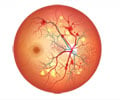Two monkeys were cured of color blindness thanks to gene therapy that one day may open the way to treating eye disorders in humans, scientists said on Wednesday.
The ground-breaking technique used a cold virus as a "Trojan horse" to infect cone-shaped cells in the retina, stealthily delivering a gene that provides a pigment which is sensitive to red.About 20 weeks after the treatment, the two primates began to acquire full color vision, according to the paper, published by the British journal Nature.
"(...) We knew right away when it began to work," said Jay Neitz, a professor of ophthalmology at the University of Washington who led the work.
"It was as if they woke up and saw these new colours. The treated animals unquestionably responded to colours that had been invisible to them."
Color blindness is the inability to distinguish between different hues, particularly between red and green. Instead, these colours show up in shades of grey, causing problems for everyday tasks such as recognizing traffic lights.
Red-green color blindness is the commonest disease in humans that can be pinned to just a single mutation in the genetic code. It affects between five and eight percent of males and around one percent of women, according to various figures.
Advertisement
One was called Dalton -- named after the 18th-century British scientist, John Dalton, who discovered color blindness -- and the other Sam. Both had been color-blind since birth.
Advertisement
When the monkeys traced a color pattern on a computer touch screen, they were given a reward of grape juice.
The researchers then inserted a human gene called L-opsin into a disabled cold virus and delivered it to the monkeys’ retina through several injections.
The gene colonised cone cells, the most important vision receptors in mammals, adding the missing light-sensitive pigment.
Color vision in Sam and Dalton has remained stable more than two years after treatment, the paper says.
It is the first time that a vision disorder has been corrected in primates in which all photo-receptors are intact and healthy.
It thus gives the lie to the belief that congenital vision defects become "hard-wired" through neural connections soon after birth and cannot be corrected.
"Although color blindness is only moderately life-altering, we’ve shown we can cure a cone disease in a primate, and that it can be done safely," said co-researcher William Hauswirth, a professor of ophthalmic molecular genetics at the University of Florida.
"That’s extremely encouraging for the development of therapies for human cone diseases that really are blinding," he said in a press release.
Targeting cone cells could potentially cure common types of blindness such as age-related macular degeneration and diabetic retinopathy.
Gene medicine is one of the most alluring areas of biotechnology, as it holds out the promise of blocking or reversing inherited disease. But this new frontier has also been blighted by occasional setbacks, such as an unexpected and uncontrollable response from the immune system.
Source-AFP
LIN













